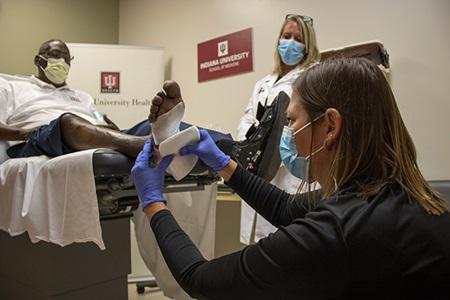
Credit: IU School of Medicine
Indiana University School of Medicine is leading the first study of the national Diabetic Foot Consortium sponsored by the National Institutes of Health (NIH) National Institute of Diabetes and Digestive and Kidney Diseases (NIDDK). The goal of the study is to prevent reopening of closed wounds by identifying a biomarker that would predict such recurrence during the process of standard wound care. Such an advanced approach to manage diabetic foot ulcers is likely to decrease amputation rates across the country.
The first study of the Diabetic Foot Consortium, made up of six centers from across the country, will be led by the Indiana Center for Regenerative Medicine and Engineering and the Comprehensive Wound Center at Indiana University Health Methodist Hospital. In addition to IU School of Medicine, the other centers of the consortium who will run this study are located at the University of Michigan at Ann Arbor, University of California–San Francisco, Stanford University, University of Miami School of Medicine and University of Pittsburgh.
Diabetic foot ulcers develop in diabetic patients with diabetic neuropathy, a condition which causes numbness in the foot. The nerves in the skin become dysfunctional, which can cause patients to injure the affected foot without feeling it. Those untreated wounds can lead to infections, and if an infection is not treated quickly, an amputation may be necessary. Even when treated, these closed wounds can reopen, posing the risk of amputation. It is necessary to know which wounds may reopen to prevent such recurrence.
“Management of chronic wounds is not an emphasis area even in most academic medical centers. With the goal to preserve overall health of our diabetic patients and prevent amputation, wound care must draw from the latest developments in science and transform,” said Chandan Sen, PhD, principal investigator of the study. Sen is the associate dean of research and director of the Indiana Center for Regenerative Medicine and Engineering at IU School of Medicine, as well as the executive director of the IU Health Comprehensive Wound Center.
“The national Diabetic Foot Consortium, made up of the top experts at the NIH and academic medicine, will deliver solutions that will improve the standard of care for the diabetic foot, thus preventing amputation,” Sen said.
According to Jay L. Hess, PhD, MD, MHSA, dean of IU School of Medicine, the Indiana Center for Regenerative Medicine and Engineering makes IU School of Medicine a leader in the innovative approaches to wound healing.
“Dr. Sen and his team are pioneers in the field of regenerative medicine. I am confident that this nationwide consortium of experts will make an immediate impact on those with diabetic wounds, not only here in Indiana, but around the world.”
Indiana ranks among the 10 states in the country with the highest amputation rates. According to data from Dartmouth Atlas, the Indiana amputation rate in 2015 was .69 per 1,000 Medicare enrollees. Counties in the western part of the state have higher rates of amputation.
“Wherever you have the most problem is also where you have the most opportunity,” Sen said. “I see Indiana as the greatest opportunity in the country to make a difference.”
Sen and his team are already at work with the IU Health Comprehensive Wound Center, which was opened on January 8, 2020 by Dennis Murphy, president and CEO of IU Health, and Hess.
“We are creating a unique care delivery model with primary wound care, specialty care and research all participating in patient care during each encounter. In addition, we are setting up a limb salvage program,” said Gayle Gordillo, MD, Chief of Plastic Surgery and Medical Director of the IU Health Comprehensive Wound Center.
The consortium’s first patient, Donnell Hayes, was treated recently in Indianapolis. Hayes is one of about 400 patients who will be enrolled in the study across all six centers, including several IU Health hospitals throughout Indiana.
“I’m very honored to be part of the study,” said Hayes, who suffers from diabetes and a diabetic foot ulcer. “I’m happy to know that my experience and treatment will benefit future patients,” Hayes said.
This is the first federal initiative of uniform wound care across the entire country, with IU School of Medicine leading the charge.
“The scope of this study is to find the right type of treatment or measurement that will predict wound recurrence and then see how we could disseminate it so the whole country can be aware of how to manage their care better,” Sen said. “At the same time, we want to take it to our own, local community and make a difference for them. We look forward to building an effective partnership with the health administration of our state to make sure that the most people benefit from this effort.”
###
IU School of Medicine is the largest medical school in the U.S. and is annually ranked among the top medical schools in the nation by U.S. News & World Report. The school offers high-quality medical education, access to leading medical research and rich campus life in nine Indiana cities, including rural and urban locations consistently recognized for livability.
Media Contact
Christina Griffiths
[email protected]
Original Source
https:/




